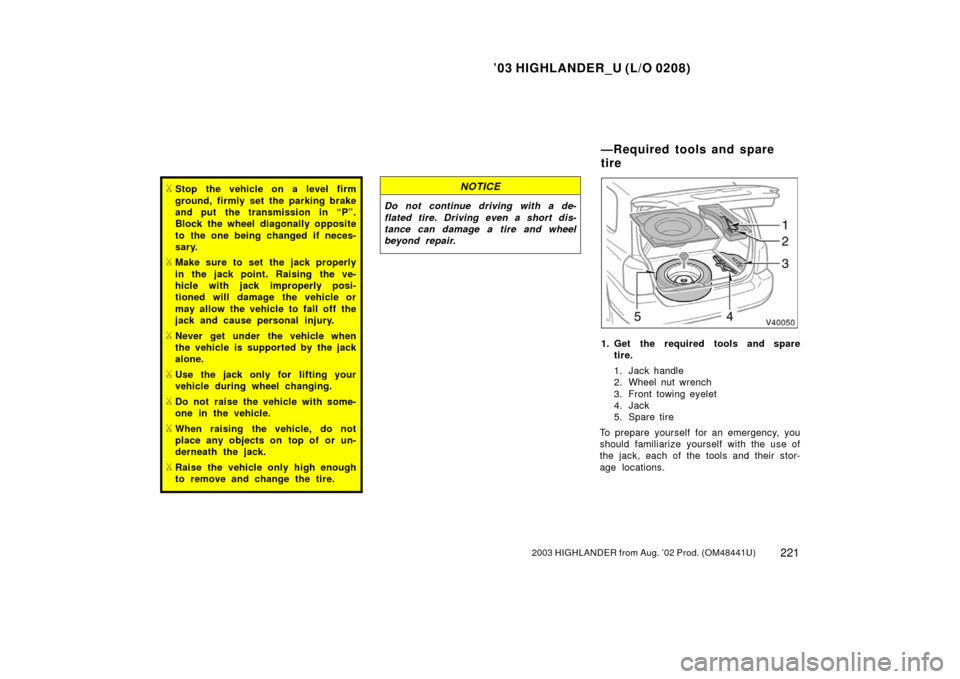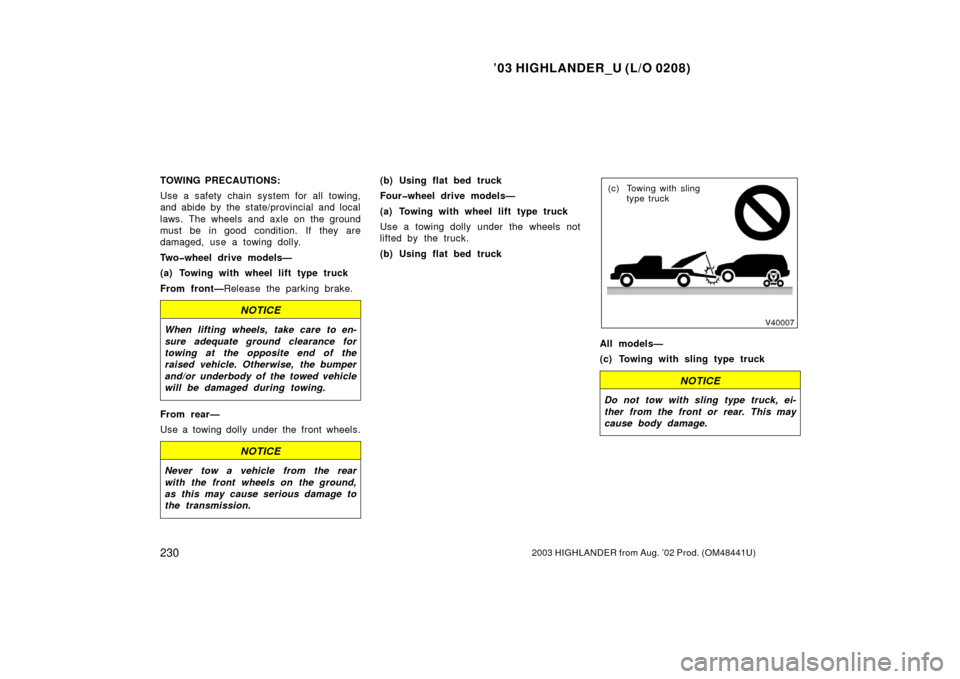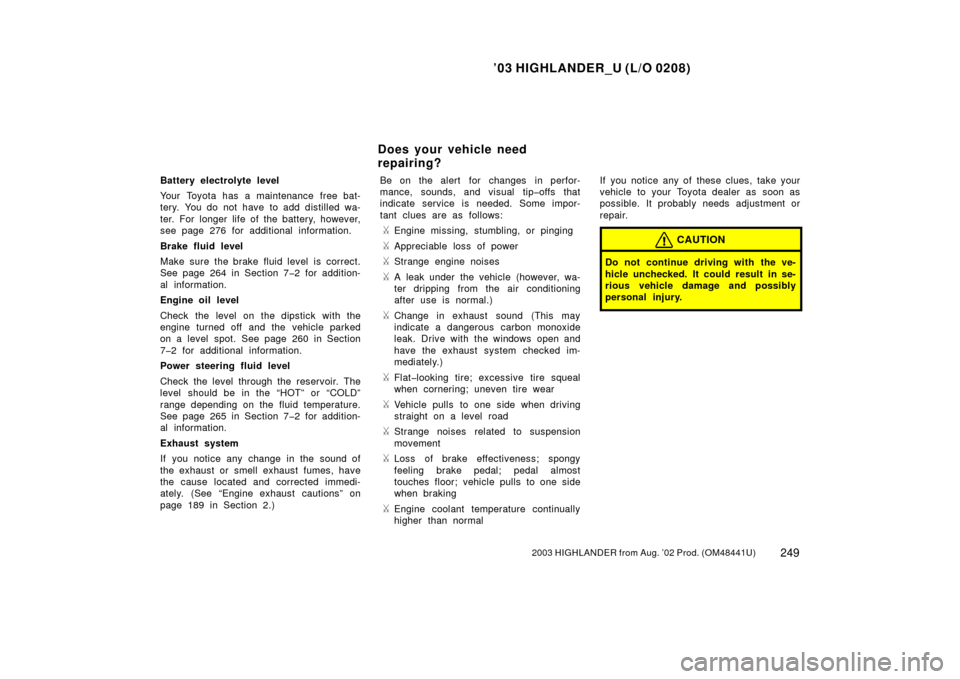Page 227 of 303

’03 HIGHLANDER_U (L/O 0208)
2212003 HIGHLANDER from Aug. ’02 Prod. (OM48441U)
�Stop the vehicle on a level firm
ground, firmly set the parking brake
and put the transmission in “P”.
Block the wheel diagonally opposite
to the one being changed if neces-
sary.
�Make sure to set the jack properly
in the jack point. Raising the ve-
hicle with jack improperly posi-
tioned will damage the vehicle or
may allow the vehicle to fall off the
jack and cause personal injury.
�Never get under the vehicle when
the vehicle is supported by the jack
alone.
�Use the jack only for lifting your
vehicle during wheel changing.
�Do not raise the vehicle with some-
one in the vehicle.
�When raising the vehicle, do not
place any objects on top of or un-
derneath the jack.
�Raise the vehicle only high enough
to remove and change the tire.
NOTICE
Do not continue driving with a de-
flated tire. Driving even a short dis-
tance can damage a tire and wheel
beyond repair.
1. Get the required tools and spare
tire.
1. Jack handle
2. Wheel nut wrench
3. Front towing eyelet
4. Jack
5. Spare tire
To prepare yourself for an emergency, you
should fam iliarize yourself with the use of
the jack, each of the tools and their stor-
age locations.
—Required tools and spare
tire
Page 236 of 303

’03 HIGHLANDER_U (L/O 0208)
2302003 HIGHLANDER from Aug. ’02 Prod. (OM48441U)
TOWING PRECAUTIONS:
Use a safety chain system for all towing,
and abide by the state/provincial and local
laws. The wheels and axle on the ground
must be in good condition. If they are
damaged, use a towing dolly.
Two�wheel drive models—
(a) Towing with wheel lift type truck
From front—Release the parking brake.
NOTICE
When lifting wheels, take care to en-
sure adequate ground clearance for
towing at the opposite end of the
raised vehicle. Otherwise, the bumper
and/or underbody of the towed vehicle
will be damaged during towing.
From rear—
Use a towing dolly under the front wheels.
NOTICE
Never tow a vehicle from the rear
with the front wheels on the ground,
as this may cause serious damage to
the transmission.
(b) Using flat bed truck
Four�wheel drive models—
(a) Towing with wheel lift type truck
Use a towing dolly under the wheels not
lifted by the truck.
(b) Using flat bed truck(c) Towing with sling
type truck
All models—
(c) Towing with sling type truck
NOTICE
Do not tow with sling type truck, ei-
ther from the front or rear. This may
cause body damage.
Page 237 of 303

’03 HIGHLANDER_U (L/O 0208)
2312003 HIGHLANDER from Aug. ’02 Prod. (OM48441U)
Front
Rear
If towing is necessary, we recommend
you to have it done by your Toyota
dealer or a commercial tow truck ser-
vice.
If towing service is not available in an
emergency, your vehicle may be tempo-
rarily towed by a cable or chain se-
cured to one of the emergency towing
eyelets on the front of the vehicle or
the right emergency towing eyelet un-
der the rear of the vehicle. Use extreme
caution when towing the vehicle.
To install the front towing eyelet, see
“—Installing front towing eyelet” on page
232 in this section.
NOTICE
Only use specified towing eyelet;
otherwise your vehicle may be dam-
aged.
A driver must be in the vehicle to steer
it and operate the brakes.
Towing in this manner may be done only
on hard�surfaced roads for a short dis-
tance and at low speeds. Also, the
wheels, axles, drive train, steering and
brakes must all be in good condition.
CAUTION
Use extreme caution when towing ve-
hicles. Avoid sudden starts or erratic
driving maneuvers which would place
excessive stress on the emergency
towing eyelet and towing cable or
chain. The eyelet and towing cable or
chain may break and cause serious
injury or damage.
NOTICE
Use only a cable or chain specifically
intended for use in towing vehicles.
Securely fasten the cable or chain to
the towing eyelet provided.
Before towing, release the parking brake
and put the transmission in “N”. The key
must be in “ACC” (engine off) or “ON”
(engine running).
CAUTION
If the engine is not running, the pow-
er assist for the brakes and steering
will not work so steering and braking
will be much harder than usual.
—Emergency towing
Page 240 of 303

’03 HIGHLANDER_U (L/O 0208)
2342003 HIGHLANDER from Aug. ’02 Prod. (OM48441U)
The following methods are effective to get
out when your vehicle is struck in mud,
sand or other condition from which the
vehicle cannot be driven out under its own
power. Use extreme caution when towing
vehicles. In addition, keep away from the
vehicles and towing cable or chain when
towing.
�Remove the soil and sand in the front
and the back of the tires.
�Place a stone or wood under the tires.
If you cannot shift the selector lever
out of “P” position to other positions
even though the brake pedal is de-
pressed, use the shift lock override but-
ton as follows:
1. Turn the ignition key to “LOCK” position. Make sure the parking
brake is applied.
2. Pry up the cover with a flat�bladed screwdriver or equivalent.3. Insert your finger into the hole topush down the shift lock override
button. You can shift out of “P”
position only while pushing the but-
ton.
4. Shift into “N” position.
5. Insert the cover.
6. Start the engine. For your safety, keep the brake pedal depressed.
Be sure to have the system checked by
your Toyota dealer as soon as possible.
—Tips for towing a stuck
vehicle If you cannot shift automatic
transmission selector lever
Page 254 of 303

’03 HIGHLANDER_U (L/O 0208)
2482003 HIGHLANDER from Aug. ’02 Prod. (OM48441U)
INSIDE THE VEHICLE
Items listed below should be checked
regularly, e.g. while performing periodic
services, cleaning the vehicle, etc.
Lights
Make sure the headlights, stop lights, tail
lights, turn signal lights, and other lights
are all working. Check headlight aim.
Service reminder indicators and warning
buzzers
Check that all service reminder indicators
and warning buzzers function properly.
Steering wheel
Check that it has the specified free play.
Be alert for changes in steering condition,
such as hard steering or strange noise.
Seats
Check that all seat controls such as seat
adjusters, seatback recliner, etc. operate
smoothly and that all latches lock securely
in any position. Check that the head re-
straints move up and down smoothly and
that the locks hold securely in any latched
position. For folding�down rear seatbacks,
check that the latches lock securely. Seat belts
Check that the seat belt system such as
buckles, retractors and anchors operate
properly and smoothly. Make sure the belt
webbing is not cut, frayed, worn or dam-
aged.
Accelerator pedal
Check the pedal for smooth operation and
uneven pedal effort or catching.
Brake pedal
Check the pedal for smooth operation and
that the pedal has the proper clearance.
Check the brake booster function.
Brakes
At a safe place, check that the brakes do
not pull to one side when applied.
Parking brake
Check that the pedal has the proper travel
and that, on a safe incline, your vehicle
is held securely with only the parking
brake applied.
Automatic transmission “Park” mecha-
nism
Check the lock release button of the se-
lector lever for proper and smooth opera-
tion. On a safe incline, check that your
vehicle is held securely with the selector
lever in “P” position and all brakes re-
leased.
IN THE ENGINE COMPARTMENT
Items listed below should be checked
from time to time, e.g. each time when
refueling.
Washer fluid
Make sure there is sufficient fluid in the
tank. See page 279 in Section 7�3 for
additional information.
Engine coolant level
Make sure the coolant level is between
the “F” and “L” lines on the see�through
reservoir when the engine is cold. See
page 263 in Section 7�2 for additional
information.
Radiator, condenser and hoses
Check that the front of the radiator and
condenser are clean and not blocked with
leaves, dirt or insects. See page 264 in
Section 7�2 for additional information.
Page 255 of 303

’03 HIGHLANDER_U (L/O 0208)
2492003 HIGHLANDER from Aug. ’02 Prod. (OM48441U)
Battery electrolyte level
Your Toyota has a maintenance free bat-
tery. You do not have to add distilled wa-
ter. For longer life of the battery, however,
see page 276 for additional information.
Brake fluid level
Make sure the brake fluid level is correct.
See page 264 in Section 7�2 for addition-
al information.
Engine oil level
Check the level on the dipstick with the
engine turned off and the vehicle parked
on a level spot. See page 260 in Section
7�2 for additional information.
Power steering fluid level
Check the level through the reservoir. The
level should be in the “HOT” or “COLD”
range depending on the fluid temperature.
See page 265 in Section 7�2 for addition-
al information.
Exhaust system
If you notice any change in the sound of
the exhaust or smell exhaust fumes, have
the cause located and corrected immedi-
ately. (See “Engine exhaust cautions” on
page 189 in Section 2.) Be on the alert for changes in perfor-
mance, sounds, and visual tip�offs that
indicate service is needed. Some impor-
tant clues are as follows:
�Engine missing, stumbling, or pinging
�Appreciable loss of power
�Strange engine noises
�A leak under the vehicle (however, wa-
ter dripping from the air conditioning
after use is normal.)
�Change in exhaust sound (This may
indicate a dangerous carbon monoxide
leak. Drive with the windows open and
have the exhaust system checked im-
mediately.)
�Flat�looking tire; excessive tire squeal
when cornering; uneven tire wear
�Vehicle pulls to one side when driving
straight on a level road
�Strange noises related to suspension
movement
�Loss of brake effectiveness; spongy
feeling brake pedal; pedal almost
touches floor; vehicle pulls to one side
when braking
�Engine coolant temperature continually
higher than normalIf you notice any of these clues, take your
vehicle to your Toyota dealer as soon as
possible. It probably needs adjustment or
repair.
CAUTION
Do not continue driving with the ve-
hicle unchecked. It could result in se-
rious vehicle damage and possibly
personal injury.
Does your vehicle need
repairing?
Page 258 of 303
’03 HIGHLANDER_U (L/O 0208)
2522003 HIGHLANDER from Aug. ’02 Prod. (OM48441U)
1. Engine coolant reservoir
2. Power steering fluid reservoir
3. Engine oil filler cap
4. Engine oil level dipstick
5. Brake fluid reservoir
6. Fuse blocks
7. Battery
8. Radiator
9. Condenser
10. Electric cooling fans
11. Windshield and rear window washer fluid tank
Engine compartment overview
�2AZ�FE engine
Page 259 of 303
’03 HIGHLANDER_U (L/O 0208)
2532003 HIGHLANDER from Aug. ’02 Prod. (OM48441U)
1. Engine coolant reservoir
2. Power steering fluid reservoir
3. Engine oil level dipstick
4. Engine oil filler cap
5. Brake fluid reservoir
6. Fuse blocks
7. Battery
8. Radiator
9. Condenser
10. Electric cooling fans
11. Windshield and rear window washer fluid tank
�
1MZ�FE engine